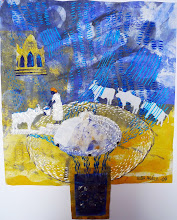Hello out there!
This is a continuation of my former blog, which was written in swedish and sent from a two-month trip in India. The address is:www.elsaiindien.blogspot.com , It´s still there in the cyberspace, so it´s possible to follow our trip step by step.
My friend Monika Lind Melander and I stayed most of the time in the small town Jaisalmer far out in the Thar-desert. We were working in a project with villagewomen in Bilaon Ki Basti.
I was doing embroideries with them and Monika was caring for the children. Read about it in the former blog.
Now I´m going to write something about how the work with impressions and inspirations from the desert is developing.
Up to now my mind is still in the desert with the women and the very enthusiastic and clever socialworkers i SKSS, Seemant Kisan Sahayog Sansthan, Kulvinder, N.D and Abbicheck.
Time flies and this is the period to apply for new grants to be able to return to Jaisalmer next autumn.
 This embroidery I made after my first visit to the desert.
This embroidery I made after my first visit to the desert.I was overwhelmed by the ambience in Jaisalmer, which did not at all remind me about desert.Around in the area there are about 250 smaller and bigger lakes. They are dug by the people in "shramdan", which is a traditional way in India to do cooperative work which gains the common society. And there are gardens , like the water-garden of the Maharadja, which has inspired to this embroidery.
"the Maharadja´s watergarden" 17x16 cm
At that time there had been a very heavy and rich monsoonrain, so
 the garden was wet and greening.In the center of it there was a pavillion in which you could see a portrait of the owner, the maharadja.
the garden was wet and greening.In the center of it there was a pavillion in which you could see a portrait of the owner, the maharadja.In the very dry environment this garden was a refreshing and lovely place. So my experience came out as the embroidery above.
Click on the picture to get a big picture
 This is the Amritsar lake, behind the wall is the watergarden.
This is the Amritsar lake, behind the wall is the watergarden.2006 after the rich monsoon it had much water. You can see how the elephant stands with the feet in water.When the lake has this much water it will last over the dry season and give water for animals and human beeings.
In the older times it was an important source of water for the whole area around.Nowadays this is not needed as there is now water from the Indira Gandhi Canal, which brings water from a tributary to the holy Ganga river. When the town Jaisalmer got this pipelined water the old water- supply-system was conciddered not important and the old wisdom about how to harvest and store water was nearly forgotten.
 2007 the monsoon was not at all so rich, so in December we found the elephant with dry feet.
2007 the monsoon was not at all so rich, so in December we found the elephant with dry feet.The impressing walls, temples, pavillions and stepwells around the lakes tells that once upon a time the lakes had an important meaning for everyday life and survival.
This is a part of the water culture in the desert that I want to learn more about.It is called "rainwaterharvesting". This old culture and the techniques are still in peoples memories and there are now efforts to find new ways to recall the knowledge.
This is what has interested me when I started my work about water in desert.Now I will try to come closer to my impressions from the trip and see what will some out in colour, cloth and stiches.
I read the book Dying Wisdom*,which tells about all the knowledge from ancient times, which is now going to a revival. *Center of Science and Environment,New Delhi.
www.cseindia.org

Inga kommentarer:
Skicka en kommentar